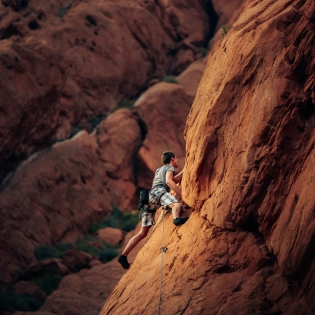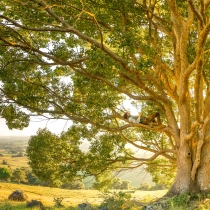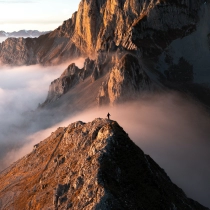When rock climbing, there are certain actions or behaviors that should be avoided to ensure safety and maintain a positive climbing experience. Here are some things you should not do when rock climbing:
-
Neglect Safety Precautions: Never compromise on safety. Don't skip wearing a helmet, neglect to double-check knots and gear, or disregard proper belaying techniques. Always prioritize safety protocols to prevent accidents or injuries.
-
Climb Beyond Your Abilities: Avoid attempting climbs that are significantly beyond your skill level or physical capabilities. Pushing your limits is important, but it should be done gradually and with proper preparation. Climbing well within your abilities helps reduce the risk of accidents.
-
Ignore Environmental Impact: Don't damage the rock or surrounding environment. Avoid chipping or altering the rock, removing vegetation, or leaving behind any trash. Follow Leave No Trace principles and respect the natural surroundings.
-
Disrespect Climbing Ethics: Familiarize yourself with the climbing ethics and guidelines of the area you're climbing in. Don't deviate from established routes, ignore access restrictions, or engage in behavior that negatively impacts the climbing community or local regulations.
-
Disturb Others: Be mindful of noise levels and avoid disturbing others in the climbing area. Respect the space and the experience of fellow climbers by being considerate, following communication etiquette, and maintaining a positive and supportive environment.
-
Compete Unsafely: While friendly competition can be motivating, avoid engaging in unsafe or reckless behavior to outperform others. Climbing should prioritize safety and personal growth rather than unnecessary risks or comparisons.
-
Overlook Hydration and Nutrition: Don't neglect your body's needs while climbing. Stay hydrated, maintain proper nutrition, and listen to your body's signals to avoid dehydration, exhaustion, or loss of focus.
-
Neglect Continuous Learning: Avoid stagnation in your climbing skills and knowledge. Don't assume you know everything or stop seeking opportunities to learn and improve. Stay open to new techniques, safety practices, and learning from experienced climbers.
By avoiding these behaviors, you can help create a safer and more enjoyable climbing experience for yourself and those around you. Always prioritize safety, respect, and responsible climbing practices.
The grade of climbs you should be able to climb largely depends on your individual climbing experience, skill level, physical fitness, and the type of climbing you are pursuing. It's important to set realistic goals and progress at a pace that is comfortable for you. Here are a few things to consider:
-
Beginner Climbers: If you are new to climbing, starting with easier routes is recommended. Focus on building a solid foundation of climbing techniques, improving your strength and endurance, and gaining experience on climbs that are well within your comfort zone.
-
Gym Climbers: If you primarily climb in a gym, the gym's grading system will help guide your progression. Start with lower-grade routes and gradually work your way up as you become more comfortable and confident. It's also beneficial to climb a variety of routes to develop diverse skills.
-
Outdoor Climbers: Outdoor climbing grades can vary widely depending on the location and grading system used. Begin by climbing routes at the lower end of the grading spectrum for the area you're climbing in. As you gain experience, you can gradually progress to more challenging climbs.
Remember that grades are subjective and can vary from one climbing area to another. They also differ between different styles of climbing, such as sport climbing, trad climbing, or bouldering. Grades are meant to provide a general indication of difficulty, but it's essential to focus on your personal progress and enjoyment of the sport rather than solely chasing higher grades.
It's a good idea to consult with experienced climbers or climbing instructors at your local gym or climbing community to receive personalized guidance and recommendations based on your specific abilities and goals. They can provide valuable insights and help you determine appropriate grades to strive for as you continue your climbing journey.
One climbing game that is popular among climbers is "Add-On." It's a fun and interactive game that can be played with a group of friends at an indoor or outdoor climbing wall. Here's how it works:
- The first climber starts by choosing and completing a short sequence of climbing moves on the wall.
- The next climber, following the first climber's sequence, adds a new move or holds to the existing sequence before completing it.
- Each subsequent climber must repeat the previous moves and add their own, creating a longer and more challenging sequence each time.
- The game continues with each climber adding on to the sequence until someone is unable to complete the entire sequence. That person is then out of the game.
- The last climber remaining, who successfully completes the entire sequence with the added moves, becomes the winner.
"Add-On" is a great way to challenge your climbing skills, memory, and creativity while having fun with others. It encourages problem-solving and helps improve your ability to remember and replicate climbing sequences.
You can also create variations of this game, such as using specific types of holds (e.g., only using slopers or only using crimps) or requiring specific climbing techniques (e.g., using only one hand or only using footholds).
One excellent exercise for improving climbing technique is "quiet feet." This exercise focuses on developing precise footwork and body control while climbing.
To practice quiet feet, choose a route or boulder problem within your comfort zone. As you climb, consciously make an effort to place your feet on the holds gently and quietly, minimizing any unnecessary noise or foot dragging.
The goal is to land each foot on the hold accurately and maintain a solid connection with the wall throughout the movement. This exercise promotes better balance, body positioning, and the development of more efficient movement patterns.
By practicing quiet feet, you enhance your ability to find and use the optimal footholds, which is crucial for maintaining balance and conserving energy while climbing. It also trains your body to be more aware of foot placements and to execute movements with precision.
Incorporate the quiet feet exercise into your climbing sessions regularly, focusing on smooth and controlled footwork. With consistent practice, you'll gradually improve your technique, leading to better climbing performance on a variety of routes and problems.
One effective warm-up exercise that also improves your climbing is traversing. Traversing involves moving horizontally across a climbing wall without ascending or descending. It helps activate the muscles used in climbing while providing a low-intensity cardiovascular workout.
To incorporate traversing into your warm-up routine, choose a section of the climbing wall with holds of moderate difficulty. Begin traversing from one end to the other, focusing on maintaining balance, precise footwork, and efficient movement. You can vary the route by using different types of holds and creating challenges for yourself.
Traversing engages your core, upper body, and lower body muscles, helping to improve overall climbing strength and endurance. It also allows you to practice maintaining body tension and develop better body awareness on the wall.
Remember to start with easier traverses and gradually increase the difficulty as you warm up. Pay attention to your body and adjust the intensity of the traversing based on your individual needs and climbing goals.
Incorporating traversing into your warm-up routine can effectively prepare your muscles and mind for more demanding climbs while simultaneously enhancing your climbing-specific skills.
Yes, warming up by climbing easy routes is a common and effective way to prepare your body for more challenging climbs. Start with routes below your maximum difficulty level to gradually increase blood flow and warm up your muscles. Focus on smooth movements and proper technique. Adjust the intensity and duration of your warm-up based on how you feel. Prioritize a proper warm-up to reduce the risk of injury and optimize your climbing performance.
It depends on your goals for climbing and why you are doing it in the first place. When I started climbing I went all in and had 4 hour sessions on average I believe. I was quite obsessed. But, I also had a goal, to get as good as I could in the shortest amount of time.
Could I have done that with less time per session, definitely. I went 3 or 4 times a week, 4 hours each time, I wasn't really giving myself enough time to rest and recover, and I did get injured a few times. Looking back I would have definitely taken it easier and went the approach of quality over quantity. At least I would have had a better ratio to resting vs climbing. I would probably have been there for 3 hours at most and just 3 times a week.
But that is me and my body and my physical level, and that is how I can answer the question for myself, but for you, are you new to climbing? How long have you been climbing for? Would you say that you are generally physically active and are in good shape? These and more questions would help answer your question, you know yourself, and the key is to listen to yourself and to your body. If you start to hurt or get injured, reduce your climbing time. If you are capable of doing 3-4 hours at a time, go for it. If not, go for 2 hours even. If you can only do 1 hour, then do 1 hour.
If you don't have a Moon Board or Tension Board, focus on improving your climbing technique and overall strength. Practice precise footwork, body positioning, and efficient movement on different climbing routes. Incorporate exercises that target your core and antagonistic muscles to enhance your climbing abilities. Additionally, consider exploring other climbing gyms or outdoor climbing areas to challenge yourself on various routes.
Absolutely! Tricep muscles play a significant role in climbing and can contribute to your overall climbing performance. The triceps, located on the back of your upper arm, are involved in various climbing movements, including pulling, pushing, and stabilizing.
Here's how tricep muscles can help in climbing:
-
Lock-Offs: When performing lock-offs, where you hold a static position with one arm while reaching for the next hold, strong triceps help maintain stability and control.
-
Mantling: Mantling involves using your arms to push down on a hold or ledge to help propel yourself upward. Triceps provide the necessary strength for effective mantling movements.
-
Dynamic Moves: Triceps contribute to explosive movements and dynamic maneuvers, such as powerful reaches or dynamic dynos. They provide additional force during these movements.
-
Stabilization: Triceps assist in stabilizing your arm and shoulder joints, helping to maintain balance and control while climbing.
While triceps are important, it's crucial to note that climbing is a whole-body activity, and other muscle groups, such as the back, core, and forearms, also play significant roles. Developing overall strength and maintaining a balanced training regimen that targets multiple muscle groups will enhance your climbing abilities.
Including exercises like tricep dips, push-ups, and overhead tricep extensions in your training routine can help strengthen and condition your triceps specifically for climbing. However, remember that climbing technique, balance, and efficient movement are equally vital aspects of successful climbing.
The amount of chalk in a chalk bag is a matter of personal preference and can vary among climbers. Some climbers prefer to have a generous amount of chalk in their bag, while others prefer a more minimal amount. Ultimately, the goal is to have enough chalk to keep your hands dry and provide good friction without excessive wastage.
A common practice is to fill the chalk bag about halfway to three-quarters full. This allows for enough chalk to coat your hands when you dip them in the bag, while still leaving room for the chalk to disperse and distribute evenly. It also helps prevent excessive spillage or clumps of chalk falling out of the bag.
Keep in mind that using too much chalk can lead to wastage and create a mess, while using too little may not provide adequate grip. It's a good idea to experiment with different amounts of chalk to find the quantity that works best for you and your climbing style. Over time, you'll develop a sense of how much chalk you personally prefer and can adjust accordingly.
Additionally, it's important to use chalk responsibly and be mindful of the environmental impact. Try to minimize chalk spills and avoid excessive chalk dust in the climbing area. Respect any specific regulations or guidelines regarding chalk usage in the climbing location you are in.



